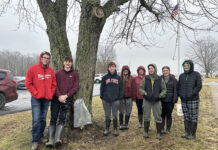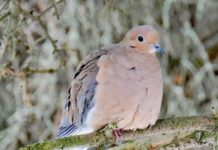There are many people who have become active in amateur wildlife management. Their motivation can stem from an interest in wildlife observation, improving hunting opportunities, managing timber, windbreak installations, using grassland programs that provide habitat and increase their land’s ability to handle water loads, filtering strips to improve groundwater quality, decreasing flood damage and just for fun.
Food plotting
While programs such as the Conservation Reserve Program, administered by the U.S. Department of Agriculture’s Farm Service Agency, and private lands projects, supported by Pheasants Forever, are responsible for larger acreage conversions to wildlife habitat, the interest in planting smaller scale projects has been steadily growing, including food plotting for wildlife.
Food plotting can be a little misleading since it can cover many projects. Since the work does take some time and money, it’s wise to have a plan before beginning the ground work.
Goals. First, let’s decide what the goals are that we hope to achieve and how to decide on a course of action.
The first step is to take a close look at the size and layout of the property and what species you hope to affect. Looking at a large backyard and planning several pollinator patches is quite different than developing a series of food sources for deer or prime nesting and bugging areas for turkeys.
By visiting your county auditor’s website, you can obtain aerial/satellite photos of the property you want to improve to assist in evaluating planting locations.
Soil test
Once the site(s) are selected, it’s a good idea to do a soil test to determine any fertilizing needs and gain insights as to which plants are best suited to the area.
Additionally, you can obtain soil maps from the county’s soil and water conservation district office. There have also been a number of books, and at least one good magazine, devoted to the subject and this would be a good time to add one to your home library.
Remember that the size of the area is important. A small pollinator area measured in square feet is great for developing a diverse yardscape, but you’re going to need to think bigger when your goal is supplying over-wintering birds forage sources or you’re trying to coax a big buck to stay in the area.
Plants
Plant types are next on the list of considerations. I always encourage that permanent plantings be done with native species. They’re genetically best adapted to the area, and wildlife are accustomed to using them for food and cover.
If you live close to an area that is prone to hold surface water after a rain or that floods during high water events, research your tree, shrub and ground-cover plantings accordingly. Some plants, like alfalfa, just don’t do as well when their feet keep getting wet. If the area is drier, the same effort should be applied to come up with the best choices.
The OSU Extension Service (extension.osu.edu) and Penn State Extension (extension.psu.edu) both offer a great deal of valuable insights.
Experts
Next, you’re going to need to find trees, plants and seed stock. Once again, your extension agent and SWCD are a good start, but there are other experts who can help.
You can also contact the Ohio Division of Wildlife and request to talk to a private land biologist (800-WILDLIFE). They have a lot of experience with wildlife management issues and are well versed in federal and state conservation programs and plant selections.
Your local Pheasants and Quail Forever biologist is another important avenue. They can help to direct you to your best habitat choices for the area you hope to improve (pheasantsforever.org/Habitat/findBiologist.aspx).
As an organization valued for its ability to help get habitat into the ground on private property, PF also offers specialized wildlife plot mixtures tailored to specific types of soils. With catchy names like Fatal Fall Forage, Winter Wonderland, Quick Cover, Lucky 13 Whitetail, Tree Stand Treat, Quail Quisine, Blizzard Buster, Rooster Booster, Winter Shield and Buck-Bird-Brood Food, these pre-selected blends help ease the choices.
All the information including site preparation and planting guides are available on the PF website in their Habitat Store (pfhabitatstore.com). A quick search of the internet will help you locate other seed sources as well as what you may find locally available at farm supply and sporting goods stores. I’ve even spotted some seed mixes being sold at a Walmart.
Equipment
Next on the list is what equipment is going to be needed. Small pollinator patches can be handled with a rototiller and hand tools but larger areas will need larger equipment.
Part of the need will be based upon the condition of the planned site. Has it been recently tilled as a farm field or are you breaking new ground? Is it in a wooded clearing with a lot of shade or is it in full sun?
Then consider the type of planting. Is this a seasonal “throw and grow” planting requiring minimal groundwork or is this an area that you expect to last for several years such as clover patch, tall grasses and wildflower blends, or is it rows of pines, nut-bearing trees or fruit-producing shrubs that will last for generations?
You may find that much of the work can be done behind an ATV, but some jobs will require ground-working equipment. These hobby projects have breathed life into the once obsolete one- and two-bottom plows, small-scale discs, drags, cultipackers and two-row corn planters.
The one piece of equipment you’ll find invaluable is a good brush mower. By checking farm auctions, you may find some of this old agricultural ground gear but don’t fret if you can’t. The popularity of putting in habitat plots has driven manufacturers to offer plenty of new choices. There are even some private businesses springing up that will plant plots for you.
On the other hand, you may find that your friends are willing to help out. Putting in food and habitat plots have become a favorite pastime among family and friends. They learn to share their knowledge, research and equipment for the betterment of wildlife.
Pooling information is always a great idea and one that may prevent early mistakes. I’ve seen, and put in a few, poorly planned plots and, while I give them all an ‘A’ for effort, a little more planning and research would have vastly improved results.
An experienced helping hand is always welcome, especially one that’s been dirty a few times and has already made a mistake or two — sometimes those are the best teachers.
So, get a head start on your work by doing some research. Visit PF’s habitat food plot resources page (www.pfhabitatstore.com/resources) and Whitetails Unlimited Food Doc’s page (www.whitetailsunlimited.com/conservation/foodplotdoc) for some valuable pointers.
Some may think food and habitat plots are done only with the goal of producing a big buck, a long beard Tom or coaxing in doves. It’s not.
Improving habitat for wildlife impacts all species that use a particular area. Good nesting and brooding cover for pheasants also benefits meadowlarks and bobolinks. A food plot helps song birds and foraging critters make it during rough winter storms. Tall warm season grasses and dense shrub plantings fight off winter winds and wrap wildlife in a safe, protective glove.
While you may want to bag a good buck, never overlook the value that you’re providing to all of our wild neighbors.
“When we try to pick out anything by itself, we find it hitched to everything else in the universe.” — John Muir












